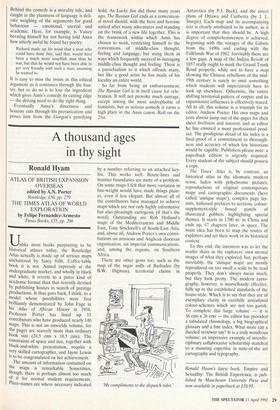A thousand ages in thy sight
Ronald Hyam
Unlike most books purporting to be historical atlases today, the Routledge Atlas actually is made up of serious maps uncluttered by fancy frills. Coffee-table book it is not. Aimed expressly at the undergraduate market, and wholly in black and white, it reverts to a purer kind of academic format than that recently devised b), publishing houses in search of prestige productions. It thus goes back, I think, to a model whose possibilities were first brilliantly demOnstrated by John Fage in his Atlas of African History in 1958. Professor Porter has lined up 15 contributors who have produced nearly 140 maps. This is not an unwieldy volume, for the pages are scarcely more than ordinary book size (24.5 cms x 18.5 cms). The constraints of space and size, together with black-and-white presentation, require a yery skilled cartographer, and Jayne Lewin is to be congratulated on her achievement.
The amount of information contained on the maps is remarkable. Sometimes, though, there is perhaps almost too much of it for normal student requirements. Place-names are where necessary indicated
by a number referring to an attached key- list. This works well. Route-lines and frontier boundaries are more of a problem. On some maps I felt that more variation in line-weight would have made things plain- er, even if less elegant. But almost all of the contributors have managed to achieve maps which are not only highly informative but also pleasingly cartogenic (if that's the word). Outstanding are Rob Holland's maps of the Mediterranean and Middle East, Tony Stockwell's of South-East Asia, and, above all, Andrew Porter's own contri- butions on missions and Anglican diocesan organisation, on imperial communications, and, among the regions, on Southern Africa.
There are other gems too, such as the map of the sugar mills of Barbados (by B.W. Higman), territorial claims in 'My compliments to the dispatch rider.' Antarctica (by P.J. Beck), and the street plans of Ottawa and Canberra (by .1. L. Sturgis). Each map and its accompanying text is clearly attributed to its author, as it is important that they should be. A high degree of comprehensiveness is achieved, beginning with the voyages of the Cabots from the 1490s and ending with the Falklands War of 1982. Inevitably there are a few gaps. A map of the Indian Revolt of 1857 really ought to mark the Grand Trunk Road properly; while not to have a map showing the Chinese rebellions of the mid- 19th century is surely to omit something which students will imperatively have to look up elsewhere. Otherwise, the entire shifting territorial pattern of empire and its expansionist influences is effectively traced. All in all, this volume is a triumph for its editor, Andrew Porter. His own maps and texts almost jump out of the pages for their sheer liveliness and interest; and as editor he has ensured a most professional prod- uct. The prodigious detail of his index is a final proof of a commitment to thorough- ness and accuracy of which few historians would be capable. Publishers please note: a paperback edition is urgently required. Every student of the subject should possess a copy.
The Times' Atlas is, by contrast, an historical atlas in the idiomatic modern sense, laden with polychrome picture,,, reproductions of original contemporary maps and cartographic documents (here called 'antique maps'), complex page lay- outs, italicised prefaces to sections, colour- supplement-style boxed panels of illustrated gobbets highlighting special themes. It starts in 1700 itc in China and ends up, 47 chapters later, in space. The main idea has been to map the routes of explorers and set their work in its historical context.
To this end, the intention was to let the reader share in the explorers' own mental images of what they explored, but, perhaps inevitably, the 'antique maps' are mostly reproduced on too small a scale to be read properly. They don't always mean much, but they look pretty. The modern carto- graphy, however, is marvellously effective, fully up to the established standards of the
house-style. Which is to say that they are of exemplary clarity in carefully articulated colour-schemes which are not too garish.
To complete this large volume — it is 36 cms x 26 cms — the editor has provided a tabulated chronology, a big biographical glossary and a fine index. What more can a dazzled reviewer say? It is a truly wondrous volume: an impressive example of interdis- ciplinary collaborative scholarship matched to a stunning expertise in state-of-the art cartography and typography.
Ronald Hyam's latest book, Empire and Sexuality: The British Experience, is pub- lished by Manchester University Press and now available in paperback at £10.95.


















































 Previous page
Previous page